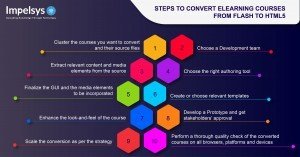It’s very much known that on Jan 1, 2020 Adobe Flash will become obsolete and all the browsers will stop supporting content created using Flash. As about half the elearning content today is consumed on mobile devices and major portion of learning budget is targeted for mobile learning, HTML5 is the obvious choice for development of elearning courses as it supports all desktop platforms and mobile devices, allowing fully leveraged mobility, and ease of access.
In our previous post, we talked about why HTML5 is the obvious choice for modern day elearning content. Here, we will talk about migration/conversion of Flash content to HTML5, scope of enhancing the courses, and making them more effective for modern elearning using various rapid authoring tools.
Here are the steps to convert Flash Content to HTML5

Approaches to Convert Flash Content to HTML5
There are various approaches we can take to convert Flash content to HTML5. Depending on the requirement, one of the approaches is followed.
If the elearning course does not have a lot of media elements we republish the source files using updated authoring tools that give a HTML5 compatible output, which means the courses are platform and device independent.
There might be a situation where we don’t have the source files of the Flash courses anymore, in this case we record the Flash courses in the form of a .mp4 video, import them into one of the rapid authoring tools and publish them as HTML5 courses.
Conversion of Flash content to HTML5 gives us an opportunity to enhance the legacy courses. Flash courses have been used for years and they have been based on learning strategies of many years back. Maybe it’s time not just to convert the Flash courses to HTML5 but also to overhaul your learning strategy. Maybe it’s time to add interactive elements, an effective instructional design strategy, social learning aspects, and micro learning to your learning strategy. This is the right time to recreate that powerful learning content which is equipped with all enhancements and is at par with modern learning techniques. If this is the case you can revamp the courses or recreate them from scratch using the latest authoring tools.
This is the right time to recreate a powerful learning content equipped with all the enhancements that are at par with modern learning techniques. You can revamp the courses or recreate them from scratch with a revised instructional design strategy, and media elements using the latest authoring tools
It’s a good practice to evaluate the worthiness of the entire exercise before embarking on the conversion process. Maybe it’s wiser to build HTML courses from scratch and retire the existing Flash based courses, or save a portion, and enhance the rest with interactivity. Complexity level rises with the level of enhancement and it needs a careful analysis of factors like, the size of the curriculum, volume of media, animations in the course, the objective of the course, and more.
Depending on the current state of the elearning content and the learning strategy of the organization we decide what level of enhancement elements to be used for the new HTML courses. Organizations that have an inhouse expertise pass it on to the responsible teams for the migration or conversion. What should organizations without in-house skills do? Whom do they consult?
If the volume of content is huge it’s worthwhile to outsource the conversion project to an experienced vendor with a track record in elearning and content technology. Impelsys has been in the edtech industry for over a decade now and we have expertise in Flash to HTML5 conversion of elearning courses. If you want to know more about our services, contact us at corpmarketing@impelsys.com